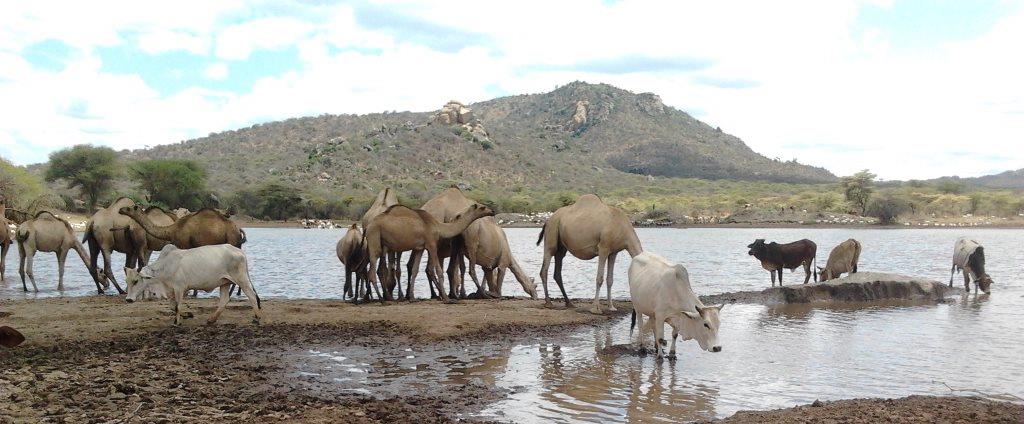The Pastoralist Livelihood
Migrant pastoralists on the arid and semi-arid lands (ASAL) of East Africa are among the poorest and most vulnerable people on earth. Most of their economic activity is based around livestock herding and management. Cattle, camel, sheep, and goats are the most common animals and function much like “banks on legs” – these animals represent the bulk of the asset wealth of the households that own them. There are over 8 million migrant pastoralists in Ethiopia and 3 million in Kenya, accounting for a significant proportion of agricultural GDP and grazing land in each country.
The pastoralist livelihood is remarkably adaptive to the risky and fragile ASAL setting. Under normal dry-season conditions, herds access remote water and vegetation resources, sometimes hundreds of kilometres away from the home village. However every few years the rains fail with severe consequences: drought, massive loss of livestock (which can lead to “falling out” of being an active livestock herder), a spike in the need for food aid, and human suffering. Earlier work by Travis Lybbert, Chris Barrett, Solomon Desta, and D. Layne Coppock (2004) provides strong evidence on the presence of poverty traps in this setting, and I have forthcoming work indicating that these poverty traps are closely connected to whether a household falls out of participating in mobile pastoralism.

An Innovative Solution … But Also More Questions
In response to this evidence, a multi-national group of researchers and policymakers banded together to develop a micro-insurance product—called Index-based Livestock Insurance (IBLI)—that would provide pastoralists with cash payouts to help them get through severe droughts. The research team carefully embedded meticulous data collection and evaluation through the project roll-out, and a number of fascinating findings have been emerging on the direct impacts of IBLI, which has been discussed elsewhere on this blog by Nathan Jensen.
While there is a lot of excitement about IBLI, the prospect of scaling such a product raises further questions: what will be the consequences of widespread uptake of this insurance for markets and the environment? Could IBLI stimulate pastoralists to accumulate ever larger livestock herds (as livestock become a relatively more attractive investment) and/or focus less on rangeland sustainability (if pastoralists feel that they don’t have to put as much effort into maintaining the vitality of livestock)? Such behaviours could lead to unintended consequences, including long-term environmental damage that could threaten the sustainability of the ecosystem.
With funding support from the Australian development aid agency, I am working with colleagues from Cornell University (in the Dyson School of Applied Economics and Management, the Institute for Computational Sustainability in the Department of Computer Science and the Institute for Resource Information Sciences in the Department of Crop and Soil Sciences), Georgia Tech, Stanford University, the International Livestock Research Institute, the US Department of Agriculture, and the Helmholtz Centre for Environmental Research to examine the environmental impacts of IBLI and address whether policymakers considering scaling innovative microinsurance products should be concerned about ecosystem mismanagement.

Our Approach
Getting at these questions is not totally straightforward. It is difficult to measure herd movement and grazing patterns; herd movements are generally measured using survey data from pastoralists and measurement error is likely a problem for such a complex recall variable. It’s also challenging to construct unified policy advice given the variety of potential impacts of insurance on environmental outcomes. While there is emerging work looking at “spillovers” of microinsurance in other contexts, this project is (to our knowledge) the first study to look in particular at prospective environmental impacts.
To deal with the data challenge we’ve been working with Dr. Pat Clark, an international-leading expert on the measurement, modelling, and analysis of livestock movements. Specifically, we’ve installed 60 GPS location collars on a set of cattle from a number of households in Ethiopia since 2011, giving us data on their locations at 5-minute intervals, and matched that to a rich set of complementary remote sensing and geographic data. We’re also bringing theoretical models to bear on the data, which allows us to tie together herd accumulation, movement choices, and the potential effects of insurance. By modelling the spatio-temporal choices of pastoralists over locations, we can simulate what would happen under alternative scenarios (for example, scaled-up insurance, different weather patterns due to climate change, herd re-stocking policies, etc.).
Thus far the project has generated a conference paper on the modelling of pastoralist movement preferences that has been presented at one of the world’s leading computer science conferences. We’re currently revising a working paper that presents analysis on the impacts of randomized provision of IBLI on herd stocking and herd movement behaviours. We plan to discuss these evolving papers and future outputs in subsequent blog posts!


That’s cool to know Dr. Clark does modelling and livestock movement. Reading this got me wanting to learn more about livestock insurance. Mostly because my father talked to me about looking into this after he bought his first farm property.